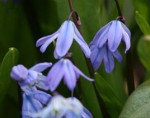 Whether growing along the edge of a deciduous woodland or under shrubs with daffodils, Siberian squill is a welcome sight in spring. The bright blue color brightens up any landscape and is all the more pleasing because it blooms early and brings sparkle and fragrance to the landscape as winter changes to spring. One or more slender stems bears a bell-shaped, violet-blue, nodding flower above a clump of mid-green, glossy, grass like leaves. Squill naturalize easily and a few bulbs will grow into a hearty clump that will continue to flower and multiply for years with little care. In some areas squill can be planted in grassy areas because the plants go dormant by early summer when the grass needs mowing. To add to its appeal is the fact that most mammals (like deer) don’t like it.
Whether growing along the edge of a deciduous woodland or under shrubs with daffodils, Siberian squill is a welcome sight in spring. The bright blue color brightens up any landscape and is all the more pleasing because it blooms early and brings sparkle and fragrance to the landscape as winter changes to spring. One or more slender stems bears a bell-shaped, violet-blue, nodding flower above a clump of mid-green, glossy, grass like leaves. Squill naturalize easily and a few bulbs will grow into a hearty clump that will continue to flower and multiply for years with little care. In some areas squill can be planted in grassy areas because the plants go dormant by early summer when the grass needs mowing. To add to its appeal is the fact that most mammals (like deer) don’t like it.
Type: Bulb.
Bloom: One or more purple-green stalks per clump bear violet-blue, fragrant, nodding flowers 1” across in early spring.
Foliage: Shiny mid-green leaves, 5” long and ¾” wide, are produced in clumps. The leaves are smooth and taper to a blunt point.
Size: 4-6” H x 4-6” W; forms clumps.
Light: Full sun to part sun.
Soil: Rich, humusy, moist, well-drained.
Hardiness: Zones 2-7.
Pests and Diseases: None of importance but root rot can be a problem is soil is too wet.
Propagation: Self-sows; divide in fall.
Companion plants: Yellow daffodils; spring blooming shrubs.
Outstanding Selections:
 ‘Alba’ (white)
‘Alba’ (white) ‘Azurea’ (azure blue)
‘Azurea’ (azure blue) ‘Spring Beauty’ (deepest blue; very robust)
‘Spring Beauty’ (deepest blue; very robust)